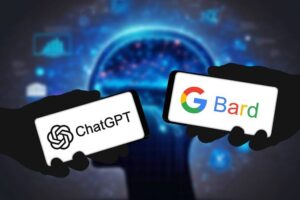ChatGPT and BERT-Based BARD (Bidirectional Attention Representation for Dependencies) are two cutting-edge language models that have gained prominence in natural language processing (NLP) applications. This synopsis aims to provide a comprehensive comparison of these models, highlighting their key features, strengths, and applications.
Introduction:
Let’s embark on a journey into the world of language models with two standout players—ChatGPT and BARD. These cutting-edge language models share the common goal of understanding and generating human-like text, but they each have their own unique traits. In this article, we’ll explore the ins and outs of ChatGPT and BARD, shedding light on what makes them tick and how they stand out from each other.
1. Getting to Know the Models:
Developed by OpenAI, ChatGPT is built on the GPT (Generative Pre-trained Transformer) architecture. It learns from a diverse range of internet text, giving it the ability to generate responses that are both relevant and coherent.
Meet BARD, short for Bidirectional and Auto-Regressive Transformers. Unlike ChatGPT’s one-way thinking, BARD’s bidirectional nature means it considers context from both sides, adding a unique layer of understanding to its responses.
2. Reading Between the Lines:
ChatGPT is a pro at generating responses based on what came before. However, it might face challenges in maintaining long-term coherence, occasionally producing responses that make sense on their own but lack overall consistency.
With its bidirectional design, BARD captures context more effectively. This could result in responses that feel more grounded in the conversation, providing a smoother and more coherent user experience.
3. Tailoring to Fit:
OpenAI has equipped ChatGPT with fine-tuning capabilities, allowing developers to customize the model for specific use cases. This flexibility enhances its adaptability across a variety of applications.
BARD also supports fine-tuning, giving users the power to tailor the model to their specific tasks or industries. This feature adds to its versatility, making it a strong contender for diverse requirements.
4. Navigating the Challenges:
Just like its counterparts, ChatGPT isn’t immune to biases, occasionally generating content that might be inappropriate or politically sensitive. OpenAI has implemented safety measures, but ethical concerns remain.
BARD faces similar challenges with biases and ethical considerations. The field of ethical AI is continuously evolving to address these issues and promote responsible usage.
5. Real-World Applications:
ChatGPT is the go-to for a wide range of scenarios, including content generation, conversational agents, and customer support. Its adaptability makes it a versatile solution for various use cases.
BARD shines in tasks that demand a deep understanding of context, such as content summarization, question answering, and document analysis. Its bidirectional capabilities make it a valuable player in these specific domains.
6. Strength in Numbers:
OpenAI has fostered a vibrant community around ChatGPT, providing platforms for developers to share insights, address challenges, and collaborate on improvements.
BARD benefits from a engaged community, with developers actively contributing to its growth and enhancement. The collective efforts of the community play a crucial role in refining the model over time.
Conclusion:
In the vast landscape of language models, both ChatGPT and BARD bring their own unique strengths. ChatGPT’s adaptability and versatility make it a reliable all-rounder, while BARD’s bidirectional approach adds depth to its contextual understanding. The choice between the two depends on your specific needs, guiding developers and organizations in harnessing the power of these advanced language models for their applications.

Leave a Comment